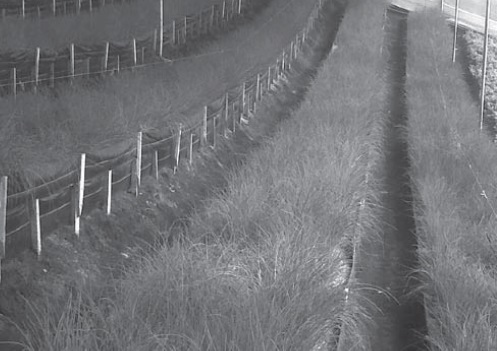Effect of greenhouse heights on the production of aromatic herbs in Colombia. Part 1: Chives (Allium schoenoprasum L.)

Abstract
This study aimed to evaluate the effect of greenhouse heights on a crop of chives. Tests were conducted in three greenhouses that had the same dimensions, but with different channel heights of 2; 2.5 and 3 m, located in Carmen de Viboral, Antioquia (6°05'09"N and 75°20'19"W, 2.150 m a.s.l.). Temperature and relative humidity measurements were taken every 30 min for 3 years, and the crop production was assessed. A multiple linear regression, colinearity analysis, and analysis of heteroscedasticity were carried out to determine the climatic variations caused by the differences in height of the greenhouses and to determine differences in the production levels. For the statistical analysis, SPSS was used. The results indicated that, under the studied conditions, the greenhouse height directly affected the internal weather condition; specifically, a 1 m reduction in the minimum height of the channel (from 3 to 2 m) resulted in an increase of the minimum, average and maximum temperatures of 0.37, 1.4 and 3.56°C, respectively, and, consequently, the chives crop yields had a 4.78% higher fresh weight, with a confidence level of 95%.
Keywords
Climate control, Temperature, Relative humidity, Yield
References
- Abello, J., J. Clavijo, and P. Barreno. 2006. Estudio preliminar de algunos descriptores fisiológicos en cinco hierbas aromáticas. pp. 13-15. In: Memorias Curso de Extensión: Últimas tendencias en hierbas aromáticas culinarias para exportación en fresco. Facultad de Agronomía, Universidad Nacional de Colombia, Bogotá.
- Barreño, P. 2006. Hierbas aromáticas culinarias para exportacion en fresco. Manejo agronómico, producción y costos. Facultad de Agronomía, Universidad Nacional de Colombia, Bogotá.
- Bautista-Torres, A.M., J.F. Acuña, and J.L. Martin. 2014. Comportamiento de la humedad relativa en un cultivo de lechuga (Lactuca sativa) variedad Vera, bajo dos condiciones de ambiente controlado. In: Memorias XI Congreso Latinoamericano y del Caribe de Ingeniería Agrícola. Cancún, México.
- Bernal, D.A., L.C. Morales, G. Fischer, J. Cuervo, and S. Magnitskiy. 2008. Caracterización de las deficiencias de macronutrientes en plantas de cebollín (Allium schoenoprasum L.). Rev. Colomb. Cienc. Hortic. 2(2), 192-204. Doi:10.17584/rcch.2008v2i2.1187
- Brueckner, B. and H. Perner. 2006. Distribution of nutritive compounds and sensory quality in the leafs of chives (Allium schoenoprasum L.). J. Appl. Bot. Food Qual. 80(2), 155-159.
- Clavijo, J.P. 2006. Últimas tendencias en hierbas aromáticas culinarias para exportación en fresco. Produmedios, Bogotá.
- Dahlgren, J.P., H. von Zeipel, and J. Ehrlen. 2007. Variation in vegetative and flowering phenology in a forest herb caused by environmental heterogeneity. Amer. J. Bot. 94, 1570-1576. Doi: 10.3732/ajb.94.9.1570
- Delahaut, K.A. and A.C. Newenhouse. 2003. Growing onions, garlic, leeks, and other Allium in Wisconsin: A guide for fresh-market growers. Cooperative extension. University of Wisconsin, Madison, WI.
- Fischer, G. and L.M. Melgarejo. 2014. Ecofisiología de la uchuva (Physalis peruviana L.). pp. 31-47. In: Carvalho, C.P. and D.A. Moreno (eds.). Physalis peruviana: fruta andina para el mundo. Programa Iberoamericano de Ciencia y Tecnología para el Desarrollo CYTED, Limencop SL, Alicante, Spain.
- Fischer, G. and J.O. Orduz-Rodríguez. 2012. Ecofisiología en frutales. pp. 54-72. In: Fischer, G. (ed.). Manual para el cultivo de frutales en el trópico. Produmedios, Bogotá.
- González, M.M. 2009. La gestión del clima bajo invernadero y modelos de simulación para su manejo. Memorias Curso Control climático en invernaderos. Universidad de Almería, Almería, España.
- Kleinbaum, D.G., L.L. Kupper, and K. Muller. 1988. Applied regression analysis and other multivariate methods. PWS-KENT Publishing Company, Kent, UK.
- Lambers, H., T.L. Pons, and S. Chapin. 2008. Plant physiological ecology. 2nd ed. Springer Verlag, New York, NY.
- MaroCkiene, N., R. Karkleliene, D. JuskeviCiene, and A. RadzeviCius. 2012. Investigation of morphobiological parameters of local and introduced cultivars of chives (Allium schoenoprasum L.). J. Sodininkyste Darzininkyste 31(3/4), 59-65.
- Pardo, M. and D. Ruiz. 2005. Análisis de datos con SPSS 12 Base. McGraw-Hill, Madrid.
- Pinzón, A.M., B. Castillo, and M.T. Londoño. 2013. Characterization of the mechanical properties of chives (Allium schoenoprasum L.). Agron. Colomb. 31(1), 83-88.
- Quintero, G. and J.F. Acuña. 2014. Incidencia de las películas plásticas en la variación de factores abióticos para producción de lechuga en ambientes protegidos. In: Memorias VI Edición de la conferencia científica internacional sobre desarrollo agropecuario y sostenibilidad. Agrocentro, Universidad Central “Martha Abreu” de Las Villas, Cuba.
- Roy, J.C., T. Boulard, C. Kittas, and S. Wang. 2002. Convective and ventilation transfers in greenhouses, Part 1: the greenhouse considered as a perfectly stirred tank. Biosyst. Eng. 83, 12-14. Doi:10.1006/ bioe.2002.0107
- Sadras, V.O., L. Echarte, and F.H. Andrade. 2000. Profiles of leaf senescence during reproductive growth of sunflower and maize. Ann. Bot. 85, 187-195. Doi: 10.1006/anbo.1999.101
- Salisbury, F.B. and C.W. Ross. 2000. Fisiología de las plantas. Vol. 3. Desarrollo de las plantas y fisiología ambiental. Paraninfo and Thomson Learning, Madrid.
- Sherry, R.A., X.H. Zhou, and S.L. Gu. 2007. Divergence of reproductive phenology under climate warming. Proc. Nat. Acad. Sci. USA. 104, 198-202. Doi: 10.1073/pnas.0605642104
- Villamizar, F. 2003. Calidad poscosecha y uso del frío en la conservación de hierbas frescas para la exportación. pp. 51-55. In: Memorias curso de extensión teórico práctico ”Últimas tendencias en hierbas aromáticas culinarias para exportación en fresco”. Facultad de Agronomía, Universidad Nacional de Colombia, Bogotá.
- Whittinghill, L.J., D.B. Rowe, M. Ngouajio, and B.M. Cregg. 2013. Evaluation of nutrient management and mulching strategies for vegetable production on an extensive green roof. Agroecol. Sustainable Food Syst. 40(4), 297-318. Doi: 10.1080/21683565.2015.1129011
